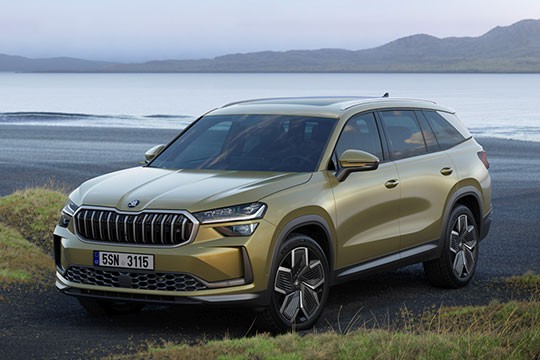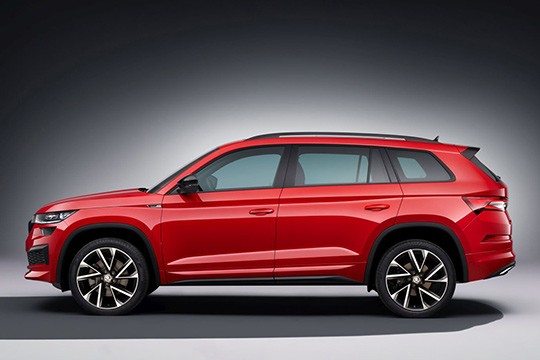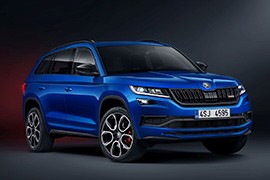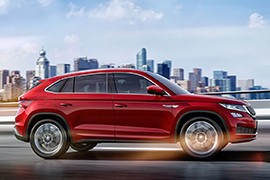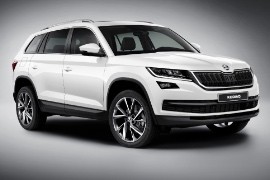SKODA Kodiaq Models/Series Timeline, Specifications & Photos
First production year: 2016
Engines: , Gasoline, Diesel
Body style: SUV (Sports Utility Vehicle)
After selling almost 900,000 units from Kodiaq’s first generation in seven years, Skoda introduced the second generation of this nameplate in the Fall of 2023, promising smarter technologies and features.
When the first generation of the Kodiaq broke covers in 2016, it stirred the European SUV market. Later, the vehicle reached other continents and was sold in 60 countries. The Czech brand built it on the same MQB A2 platform shared with the Volkswagen Tiguan Allspace or the Audi Q3, to name just two of its siblings. But thanks to its low price compared to the segment’s average, it gained popularity among those looking for a seven-seat vehicle able to go beyond paved roads and even do some light off-road on their way to camping sites or biking trails.
The second generation followed the cubist design language of the brand, although much more refined. At the front, the hexagonal grille with 13 vertical chromed slats was available with an optional light strip that ran above it. As a result, combined with the LED daytime running lights of the headlamps, it created a light signature, offering an upscale look for the vehicle. The angular headlights and fog lamps were separated by a strip, which was part of the tall bumper. On the lower side, in the apron, the automaker placed a secondary grille adorned by a hexagonal mesh and flanked by vertical vents. From its profile, the Kodiaq retained the same distinctive elements as its predecessor, featuring an ascending waistline ending into a raked-forward D-pillar at the rear side. Unlike the first generation of this mid--sized SUV, both the B- and the C-pillars were darkened to create the image of larger windows. With its raked-forward tailgate and the roof spoiler mounted at its top, the Kodiaq offered its customers a dynamic look.
Inside, Skoda made a clean design, uncluttered by too many buttons, but without being called a minimalist one either. The 13-inch touchscreen of the infotainment system stood atop the center stack in a free-floating position. Skoda adopted a new design for the HVAC system, with three rotary dials that featured 13-mm (0.5”) screens that showed various functions made by each dial. It was a combination of digital and analog made right. Fronting the driver was a 10-inch digital instrument cluster, fitted as standard for the entire range. Thanks to the longer wheelbase and bodywork, the seven-seat vehicle provided more room than its predecessor. As a result, even the two passengers seated in the third row had 920-millimeter (36.2”) of headroom, which was enough even for full-grown adults.
Under the hood, Skoda installed a choice of gasoline, diesel, and plug-in hybrid drivetrains with either front- or all-wheel-drive systems. Still, the most powerful versions were fitted as standard with AWD. The 2023 Kodiaq iV (PHEV) provided 100 km (62 miles) of pure electric range, which was enough for the daily commute, and combined with the gasoline engine, it produced 204 PS (201 HP). The Kodiaq came fitted as standard with a seven-speed automatic (dual-clutch) gearbox for all grades.
Skoda refreshed the Kodiaq SUV in 2021, after four years and 600,000 units sold globally.
The Kodiaq was a gamechanger for the Czech carmaker Skoda. It was a mid-size SUV with room for seven offered with various powerplants and drivetrains that placed it at the same level as other European brands. It was built on an extended Volkswagen MQB platform, the same used for the Tiguan Allspace.
With the 2021 range, Skoda introduced a new set of slimmer Matrix LED headlights on its biggest SUV on the market. They were standard features on the full-options trim level L&K (Laurin&Klement) and on the sportiest version, the RS. Its more upright grille made the car looks rougher than before, able to cope with difficult off-road situations even though it was more of a mall-roader than an off-roader. On its sides, the black moldings around the wheel-arches added more protection for the bodywork. The carmaker introduced a new set of 20” light-alloy wheels on the options list.
Inside, the Kodiak featured new upholstery options and contrast stitchings for specific versions on the seats and dashboard. Depending on the trim level, two or three-spoke steering wheels were fitted as standard. The carmaker offered a ten-speaker Canton sound system as standard on the L&K trim level or optional for the rest of the range. Its infotainment unit was equipped with a standard 8” touch-screen with an option for a 9.2” display. Skoda included a 10.25” TFT display for the instrument cluster as an option.
Under the hood, the carmaker introduced two turbo-diesel and three gasoline options, all turbocharged. The entry-level 1.5-liter gasoline was the only available with a front-wheel-drive and a six-speed manual, while the rest of the powerplants were paired to a seven-speed (dual-clutch) gearbox and all-wheel-drive.
Almost one year after the introduction of its biggest model, the Kodiaq, Skoda decided to launch a more powerful, sporty version that wore the RS badge.
With a long motorsports heritage behind, the Czech automaker Skoda tried to express it on some of its models. As a result, the Fabia or the Octavia got RS badges and unique features. But after launching the Kodiaq SUV in 2017, it also considered adding a similar treatment. As a result, in 2018, the car manufacturer introduced the upgraded, sportier version of this moniker, transforming the family-friendly mid-sized crossover into a sporty vehicle for seven people, plus a large trunk in the back.
Skoda tried to express the sporty character of the Kodiaq RS in the same way as it did with the Fabia and the Octavia go-faster versions. As a result, the most powerful version of the Kodiaq family came with a redesigned front grille that sported a piano-black surrounding instead of the chromed one like the rest of its siblings. The bumper featured a redesigned lower area featuring an additional lip and a hexagonal pattern for the grille. In addition, the Kodiaq RS received standard LED headlights. From its profile, the 20" light-alloy wheels were unique for this version and let bystanders see the enlarged 17" brake discs. At the back of the car, the Kodiaq RS had the same roof spoiler on top of the tilted-forward tailgate, but the lower bumper was different. I sported two chromed side trims for the exhaust system.
Inside, the seven-seat crossover has a unique black upholstery with red stitching. Skoda didn't take shortcuts when it made the cabin and used Alcantara on the door cards and all seven seats onboard. Moreover, the high-bolstered sports seats at the front featured tall seatbacks with integrated headrests. On the dashboard, center console, and center stack, the automaker added fake carbon-fiber trims, creating an upscale image for the vehicle. In front of the driver, the automaker installed a 12.3" digital instrument cluster named Virtual Cockpit, with a unique for the RS fifth mode that showed a large rev-counter in the middle, with the speed shown with digits inside it. On the second row, the automaker installed a 60/40 split-folding bench seat, which could've been moved to allow passengers to get onto the third row, which was good for two adults.
Under the hood, Skoda installed just one engine option, a four-pot bi-turbo diesel powerplant. It provided enough oomph for the driver to make them feel like in a sporty hot hatch but with a higher ground clearance. The reinforced suspension and adaptive dampers allowed the vehicle to get a lap record for a seven-seater vehicle around the Nürburgring's Nordschleife. Skoda installed a seven-speed dual-clutch automatic gearbox and an all-wheel drive system as standard for the Kodiaq RS.
The Chinese market was a highly competitive one and all the major car-makers tried to get more of it. Skoda even tried to get it with a special vehicle: the 2018 Kodiaq GT, an SUV built especially for China.
The Czech brand Skoda started its journey under the Volkswagen umbrella with just one model back in the '90s. By 2018 it already had a very wide range, from the supermini citigo to the big Kodiaq SUV. The latter was built on the same MQB platform, which made it very easy to adapt to various configurations. For the SUV-coupe market, most of the offers were made by the premium car-manufacturers. In China, there were few special models and Skoda added another one to the list: the Kodiaq GT. It was unveiled in November 2018.
From the front to the A-pillars, the car looked most like any other Kodiaq from the Chinese market. The car featured a new front bumper with more aggressive styling, especially on its sides. A new badge was inserted on the front fenders, behind the wheels. From the side, the car was the same up to the A-pillars, but an arched roofline and sloped end made the car look different.
Inside, there were some modifications to the car, depending on the trim level. The top version featured sport-bucket seats with a hole under the headrest that mimicked a pass-through racing harness. The virtual cockpit for the instrument cluster was featured as standard. The infotainment unit was a carryover from the Kodiaq model as well.
The Kodiaq GT was offered with a 2.0-liter gasoline engine. It was offered with two levels of power: 186 CP and 220 CP. The former was available with front-wheel-drive while the latter was offered only with a 7-speed gearbox and all-wheel-drive.
Who would have thought that Skoda could actually produce a large SUV to compete even with the Land Rover Discovery? Not many of you, I bet.
The large family SUV was practical, economical and simply desirable. The Skoda Kodiaq was based on the Volkswagen’s MQB platform.
While the majority of the large SUVs at the time offered seating for 7, the Kodiaq needed to keep up to stand out in the crowd. While the base Kodiaq could accommodate up to 5 occupants, the upper trim levels added 2 rear seats behind the 2nd row.
Adding the 3rd row of seats compromised the cargo area, thus sometimes it was either friends or luggages.
Otherwise, the Kodiaq’s cabin was roomy with great legroom and headroom available for the passengers in the 2nd row. With the high center console in the back, the 3rd seat was mostly suitable for children and the same applied for the 3rd row that offered limited headroom.
We consider the Kodiaq’s interior the nicest Skoda ever made. While most of the models in their catalogue had a well-made interior, they were not the most attractive.
The quality materials used throughout the cabin gave a luxury feeling and the range topping model featured even ambient lighting.
The cabin was well insulated, offering a quiet ride without any engine noise or tire roll.
An extensive list of powerplants was available, from a 1.4-liter gasoline to a 2.0-liter diesel unit. The diesel units were very punchy and all engines were refined.
